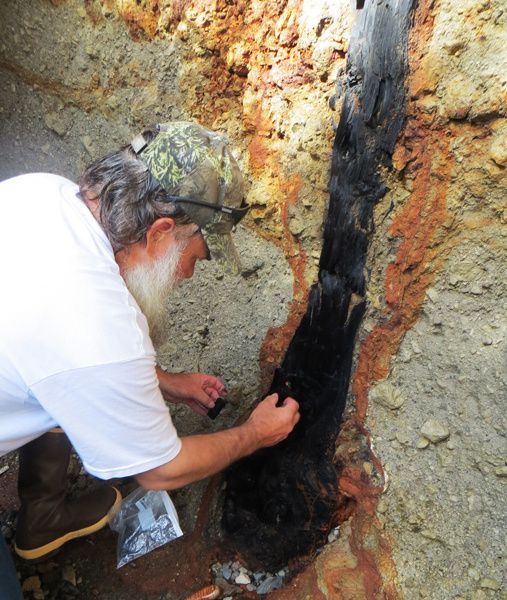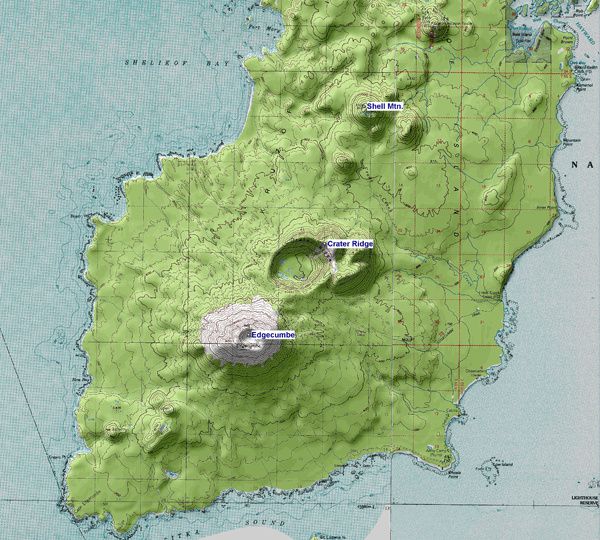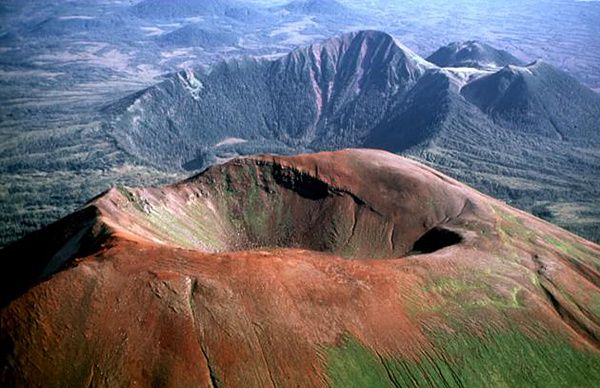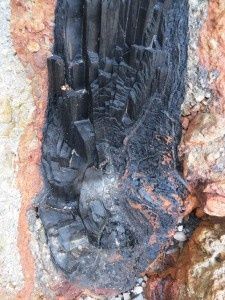Actualité volcanique, Articles de fond sur étude de volcan, tectonique, récits et photos de voyage
A group of scientists , led by a resident of Sitkan , found in the bank of a creek in Alaska an unusual relic of an eruption : a charcoal tree.
 Samples
made by Jim Baichtal , Forest Service geologist on Kruzof island - Photo Kitty LaBounty / in Alaska Public Media
Samples
made by Jim Baichtal , Forest Service geologist on Kruzof island - Photo Kitty LaBounty / in Alaska Public Media
According to the botanist K.
LaBounty, University of Alaska, " The tree was standing , largely intact , carbonized but not petrified. If we look closer, we could see its whole structure, see the place where the roots ,
some branches, nodes always are present. "
On
examination, the tree is embedded in a layer of volcanic pumice that have completely buried, so hot that it was carbonized in place and remained frozen , standing and maintained by the pumice so
far .
Jim Baichtal
, a geologist from the Forest Service , indicates that these pumice come from an eruption of Crater Ridge, one of the structures of the Edgecumbe volcanic
field, on Kruzof island. This
field covers 260 km² and includes the andesitic stratovolcano Edgecumbe , domes and craters of Crater Ridge and Shell Mountain, aligned on a SW-NE line marking a regional fissure.
 SE
Alaska - the Edgecumbe volcanic field and its major volcanoes aligned SW-NE - from a topographical relief map of the AVO - USGS
SE
Alaska - the Edgecumbe volcanic field and its major volcanoes aligned SW-NE - from a topographical relief map of the AVO - USGS
 SE
Alaska - On the foreground, the top of the Edgecumbe and his colored dacitic pumice slopes of the post-glacial pyroclastic episode - in the background , domes
of Crater ridge , wooded - Photo Jim Riehle - 05.2002 (U.S. Geological Survey , Alaska Volcano Observatory) .
SE
Alaska - On the foreground, the top of the Edgecumbe and his colored dacitic pumice slopes of the post-glacial pyroclastic episode - in the background , domes
of Crater ridge , wooded - Photo Jim Riehle - 05.2002 (U.S. Geological Survey , Alaska Volcano Observatory) .
Crater Ridge is truncated by a caldera of 1600 meters wide and 240 meters deep
.
The latest dated eruptions are phreatomagmatic explosions that took place in the middle of the Holocene, the last activity being dated by the GVP of
2220 BC ( radiocarbon dating uncorrected to this day) .
The post- glacial activity
has produced voluminous pyroclastic deposits , equivalent to 7.6 cubic kilometers of dense rock , and found to Juneau and Lituya Bay, 200 km. further north.
Pumice and charcoal wood
samples and a piece of obsidian were collected to precisely date the original explosive eruption and its chemistry.
Carbonization or petrification :


At left , detail of the carbonized tree /
Kruzof island / photo Kitty LaBounty / in Alaska Public Media.
Right, a petrified tree / Yellowstone NP - Tower
Roosevelt / photo Bernard Duyck
Carbonization, is the
transformation of an organic substance into carbon under the effect of heat . Carbonization of wood gives charcoal.
The process of petrification occurs when wood is buried under a layer of sediment where it keeps first due to a lack of oxygen, before a mineral rich water is
flowing through the sediment and replaces some just the wood cells with minerals
(mostly silicates, such as quartz ). Less than a hundred years are
probably necessary for some pieces of wood to be petrified.
Sources:
- Alaska Public Media - Tree buried by volcanic eruption could reveal seismic secrets - by E.Schoenfeld
- Global Volcanism Program - Edgecumbe
Thème Magazine - Hébergé par Overblog


